Author and historian Gail Kahover just released a new book titled Mundelein Seminary, which explores the rich history of the largest priestly seminary in the country. Today, Brandon Vogt interviews her about the book and the seminary’s past.
Brandon: What made you write a history of Mundelein Seminary?
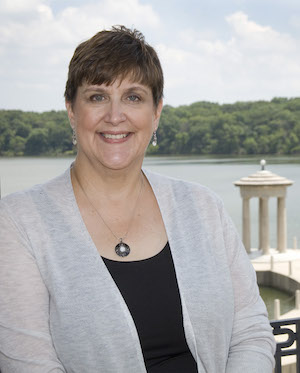 Gail Kahover: The book is actually part of my faith journey. I am a cradle Catholic, but like many who grew up Catholic in the 1960s and 1970s, I was poorly catechized. I attended a Christ Renews His Parish program at my home parish in Libertyville, IL, where my faith was rekindled and renewed.
Gail Kahover: The book is actually part of my faith journey. I am a cradle Catholic, but like many who grew up Catholic in the 1960s and 1970s, I was poorly catechized. I attended a Christ Renews His Parish program at my home parish in Libertyville, IL, where my faith was rekindled and renewed.
In 2011, I began to take classes at the Seminary as part of the Archdiocese of Chicago’s two-year Lay Leadership ministry program. Every week, I would glance around the gorgeous architecture of the seminary, the beautiful artwork in every room and even the tiny crosses that adorn each lamppost, and I wanted to learn more. I approached the Seminary’s marketing department about the book idea and they graciously gave me the go-ahead. I was thrilled. I have such a sense of peace when I am on the grounds of the Seminary. I wanted to share that joy with others through the book.
Brandon: The seminary was the dream of Cardinal George William Mundelein, who began planning the site in 1916. What was he like, and why was he the right guy to launch the seminary?
Gail Kahover: When Cardinal Mundelein was installed as the third archbishop of Chicago in 1916, he immediately set out to build both a minor and major seminary to train home-grown priests for a bourgeoning Catholic population.
In 1920, the Cardinal announced plans for the construction of a new major seminary that would rival the best in the world, feature first-class facilities, and be 100 percent American. The Archdiocese purchased 1,000 acres of pristine land in Lake County, IL, about 40 miles north of Chicago, with the help of seed money from priests and a $500,000 donation.
Mundelein was a larger-than-life figure in the 1920s and 1930s. A former New Yorker, he had close contacts with many influential people, including President Franklin D. Roosevelt, who met with Mundelein several times during his episcopacy.
Mundelein’s vision to create a world-class American seminary was realized. Today, Mundelein Seminary is the largest priesthood preparation program in the country, training priests for the Chicago and 31 dioceses around the country and the world.
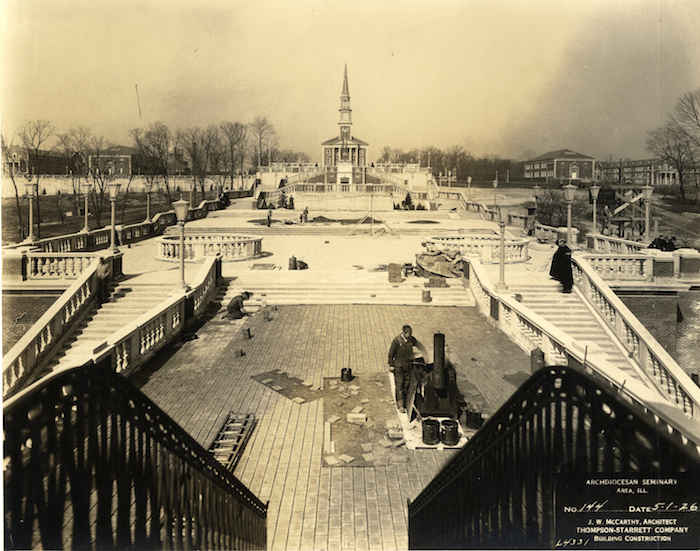
Workers put the finishing touches on the belvedere in this May 1926 photograph. The view is from the belvedere directly west to the mall and to the Chapel of the Immaculate Conception. (Photo courtesy: Joseph Cardinal Bernardin Archives and Records Center.)
Brandon: Something extraordinary happened at Mundelein in 1926. What was the event?
Gail Kahover: The Seminary hosted the closing ceremonies of the 28th International Eucharistic Congress on June 24, 1926. More than 800,000 people participated in the Mass and the procession of the Eucharist around the Seminary grounds.
The closing ceremonies capped off a week of celebrations in Chicago, from June 20 to 23. Chicago was the first American city to host the International Eucharistic Congress, which celebrates the importance of the Eucharist.
The movement of people to and from the Seminary on June 24, 1926 was the largest transportation effort in American history. Newspapers reported that approximately 18,000 cars moved in and out of Mundelein within a 24-hour period. Even more astounding was the fact that a loaded train arrived at the temporary Mundelein train station every 40 seconds over an eight-hour span. This was really an incredible feat.
The Congress also elevated Cardinal Mundelein’s stature worldwide as both a civic and religious leader. It also placed Mundelein Seminary on the international map.
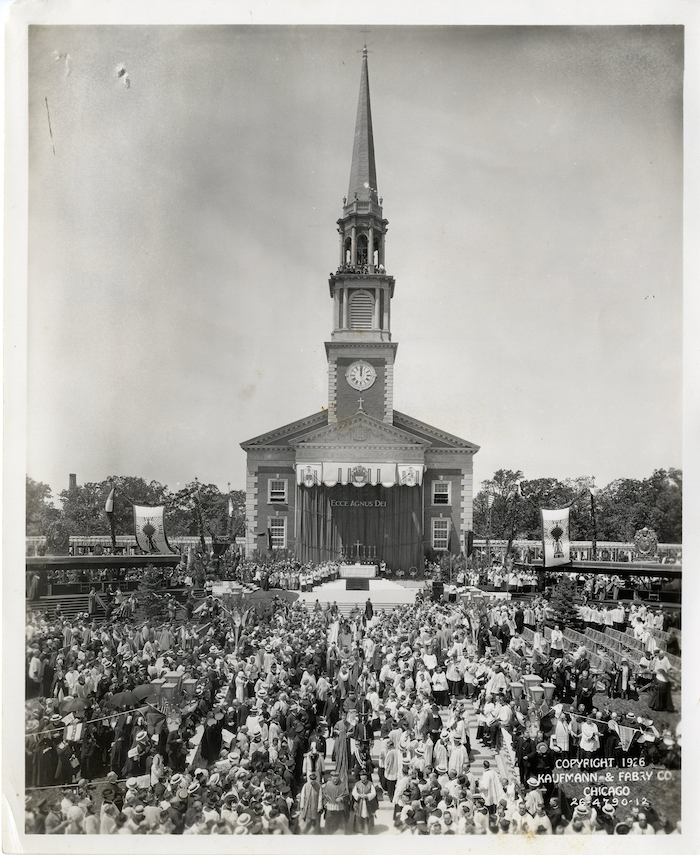
The altar for the Pontifical High Mass was set up in the front of the Chapel of the Immaculate Conception, showcasing the pageantry for the closing ceremonies of the 28th International Eucharistic Congress on June 24, 1926. (Photo courtesy: Joseph Cardinal Bernardin Archives and Records Center.)
Brandon: The seminary has welcomed many prestigious figures and churchmen, including Venerable Fulton Sheen in 1955. What did he tell the seminarians?
Gail Kahover: As part of my research, I had the great privilege of going through years of scrapbooks kept by the seminarians. One of the many jewels I uncovered was photos and commentary about the Ven. Fulton Sheen’s visit to the Seminary in May of 1955.
He encouraged the seminarians to be good speakers, but told them “don’t try to be like Bishop Sheen.” Sheen, who was a great orator and public personality, said: “Everyone is a good speaker when he is alone. Be humble about it. God will be working through you.”
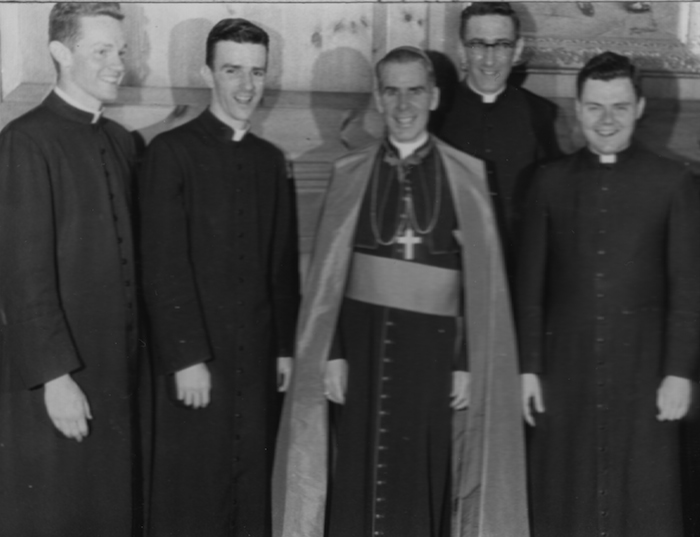
Bishop Fulton Sheen spoke to seminarians in May 1955 and posed for photographs. Sheen was a well-known personality in the 1950s and 1960s, having hosted radio and television shows, including the popular “Life Is Worth Living” program. (Photo courtesy: University of St. Mary of the Lake)
Brandon: One of the most impressive buildings on the Mundelein campus is the Feehan Memorial Library. What makes it so special?
Gail Kahover: The Feehan Library, completed in 1929, is an incredible building. Like the other buildings on campus, it’s exterior is colonial in appearance. Step inside, and you feel like you’ve entered an Italian palace.
Cardinal Mundelein attended the Propaganda Fide College in Rome, which was located in what had been the Barberini Palace. The design of the palace’s library was used as the model for the Feehan Library. When in the main reading room, you can look up and see golden bees on the ceiling, which is a symbol of the Barberini family.
Not only is the architecture stunning, the Feehan Library is an incredible resource. The Library’s collection includes more than 200,000 volumes and more than 400 periodical subscriptions. It has been recognized by the American Library Association as one of 250 World’s Great Libraries.
In addition, the McEssy Theological Resource Center, which opened in 2004 and is attached to the Library, was the first new building to be constructed on campus since 1934.
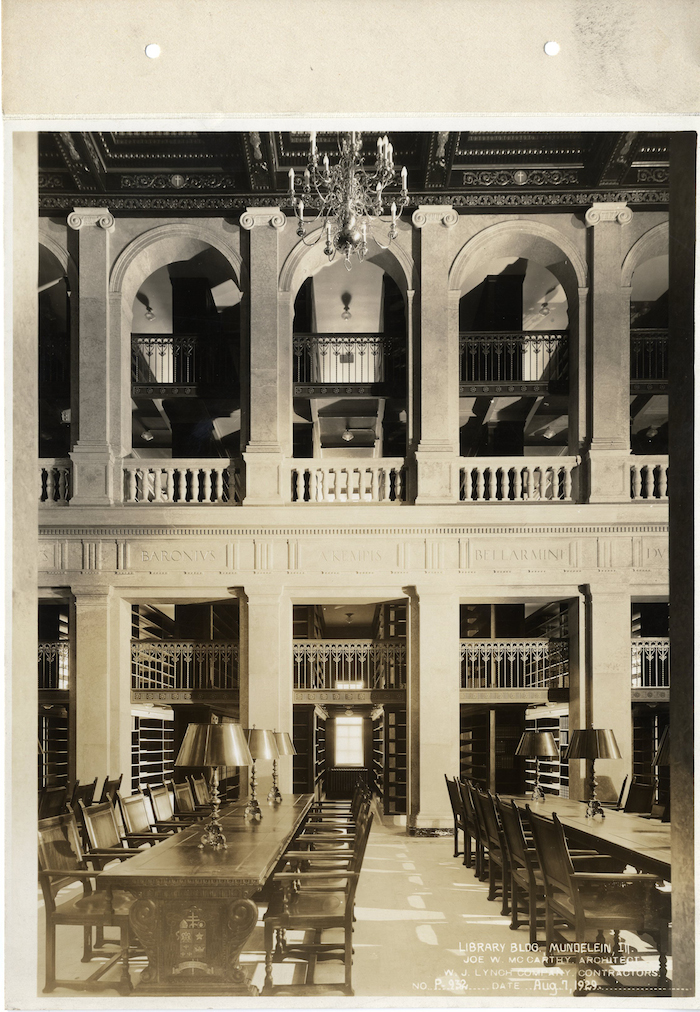
The interior of the Feehan Memorial Library looks strikingly the same today as it did in 1929 (pictured here) with some exceptions. High- speed Internet is available, and resources around the world can be accessed through the library’s extensive electronic databases. (Photo courtesy: University of St. Mary of the Lake)
Brandon: If you had to describe Mundelein in one sentence, what would you say?
Gail Kahover: The author of a book called “The First Cardinal of the West” probably summed it up the best when he called the Seminary a “Garden of God,” for it truly is a beautiful and sacred place.
Pick up your copy of Gail’s beautiful new book, Mundelein Seminary (Campus History).
